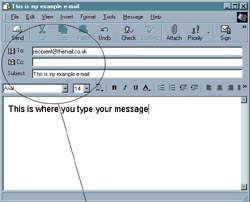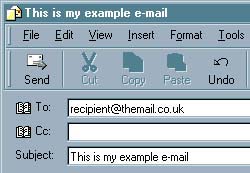| 2. E-mail |
| E-mail is short for
Electronic Mail. It is a useful communications tool that enables you to
send and receive text messages, documents, images and other files via the
internet. |
| The most common e-mail
packages are the following: |
 | Microsoft Outlook Express
 | Microsoft Outlook
 | Netscape Communicator
 | Pegasus Mail
 | Eudora |
| | | |
|
| Of these I recommend
using Microsoft Outlook Express as it is the easiest to setup and use.
Outlook Express comes automatically with versions of Internet Explorer
versions 4 & 5. You can download these from microsoft.com if you do not already
have it, or alternatively request a themail CD with IE5 from here. We will now go
through an example of how to send a message with Outlook
Express: |
| Open Outlook Express by
double clicking the icon on your desktop |
| We are assuming that
your account details have already been setup in Outlook Express by your
ISP software. If this is not the case, you will need to see their support
section for details on manually setting it up. |
| You will start off in
the Outlook Express Introduction Screen. You should see a list of
folders on the left hand side of the screen, a contacts menu
in the bottom left hand corner and the main screen informing you what you
currently have set up. Here is a quick introduction to your folders
list: |
 | Inbox - the location where incoming mail is delivered to
 | Outbox - the location where outgoing e-mails are stored until you
connect to the internet to send
 | Sent Items - saves a copy of all outgoing e-mails
 | Deleted Items - deleted e-mails are normally stored here until you
exit
 | Drafts - allows you to save part-drafted e-mails to finish later |
| | | |
|
 |
| You can customise your
folder list and add and remove folders as you so wish, but these main
folders have to be retained. |
| We will now go through
how to send an e-mail. Select the New Mail button in the top left
hand corner of your screen, or select the Message menu and select
New Message. A window will appear as below. |
 |
Here is a brief explanation of the New Message Screen:
 | To - enter the e-mail address of the person you want to send to.
Alternatively click the To button and select a name from a
contact list (you will need to set this up first).
 | CC - (Carbon Copy). Type an e-mail address here if you want to send
a copy of the e-mail to someone else. It is normally used to send a copy
to someone for 'their information'.
 | Subject - Type the subject of the e-mail here
 | The final box is where you type your message. You can use fonts,
sizes, colours and alignment but be aware that the person you are
sending it to must have software that can identify and display these
correctly. Otherwise it will not appear on their screen as it appears on
yours. So fancy e-mails are not always the answer, it is sometimes
better to keep them plain and simple!
 | The Send button at the top is what you click when you have finished
preparing your message and want to send it. The message will then move
into your Outbox. When you next dial in and connect to your Internet
Service, select the Tools menu, select Send and Receive
and select Send and Receive All. This will send any e-mails
waiting in your Outbox and also check for any incoming mails. |
| | | |
|
 |
 |
| That concludes our
introduction to e-mail. Take a few moments to browse around the
Tools menu of Outlook Express and have a look at the Address Book
and the Options Menu to customise Outlook Express to your
requirements. |
| Click here to move to section 3
>> |